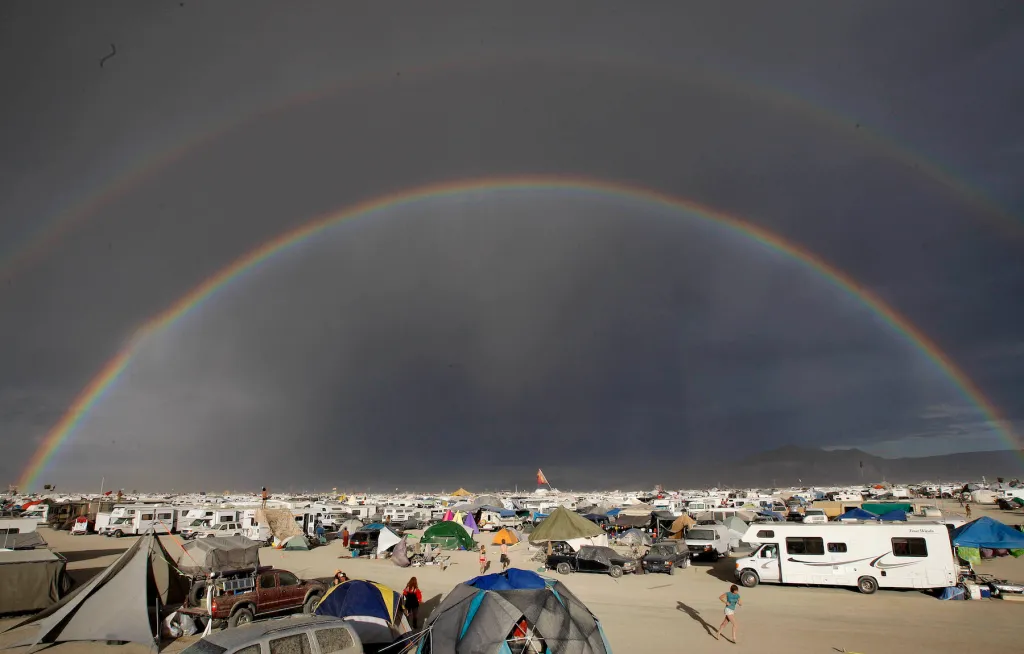Burning Man participants, trapped by persistent rain and mud, are finally departing from the remote Nevada desert festival as the organizers opened the exit gates on Monday. This brought relief to tens of thousands of festival-goers who had been stranded due to the unfavorable weather conditions.
However, even though the path to leave the festival grounds is now accessible, many of the approximately 64,000 attendees who were still on-site as of Monday may choose to stay an extra night to witness the festival’s grand effigy burning, which was postponed by a day due to the adverse conditions.
Unexpected summer showers turned the annual counterculture arts festival into a muddy ordeal. The festival’s location in Nevada’s Black Rock Desert, once the bed of Lake Lahontan 15,000 years ago, is situated 15 miles from the nearest town and 110 miles north of Reno.
For several days, up to 70,000 participants had to remain in place and conserve their resources as roads were closed, preventing vehicles from leaving.
On Sunday, officials confirmed a death at the event, triggering an ongoing investigation with limited details available.
To alleviate traffic congestion, festival organizers have advised departing attendees to exercise caution on Monday and possibly delay their departure until Tuesday. Even before the official opening of the roads, some festival-goers reported a steady stream of vehicles leaving since dawn, with many struggling through the muddy conditions.
The exit route involves a 5-mile dirt road leading to the nearest highway. Images shared on social media showed large recreational vehicles stuck in the mud up to their tire rims, with some using boards for traction.
The temporary airport serving the festival resumed operations on Monday, with all departing flights bound for Reno, Nevada, according to the Burning Man Traffic Twitter account. Flights to Burbank, near Los Angeles, and Oakland were scheduled to resume on Tuesday. The Black Rock City Municipal Airport is established in the desert for 13 days each year, utilizing two runways on the dry lake bed before disappearing.
Meteorologists from the National Weather Service announced on Monday that the rain had stopped after the area received between three-quarters of an inch to 1.5 inches of rainfall since late Friday.
Despite the instructions to stay put, some festival-goers attempted to walk or drive out to the highway, while others opted to continue celebrating despite the rain. Videos circulated on social media depicted revelers, including children, sliding through the waterlogged mud, their clothes covered in wet soil.
Brian Fraoli, a 45-year-old attendee from New York working in finance, embraced the challenging circumstances. Initially, he tried to drag his luggage through the mud in an attempt to leave but eventually decided to relax and savor the unique experience. Fraoli maintained a positive outlook, stating, “Overall, it was an amazing week, and next time we will be more prepared.”
Every year, Burning Man attracts tens of thousands of participants to the Nevada desert, where they engage in dancing, artistic creation, and communal living in a temporary, self-sufficient community. Originating as a small gathering on a San Francisco beach in 1986, the week-long festival now draws celebrities and social media influencers, with regular tickets priced at $575.
The festival’s traditional penultimate night features the burning of a massive wooden effigy of a man, accompanied by a fireworks display. Originally scheduled for Sunday night, the event was rescheduled to Monday night at 9 p.m. PDT (0400 GMT on Tuesday), as announced by the organizers.




